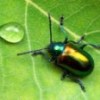
If you watch this video about a new technology for visualizing insect fossils hidden in opaque amber, pay special attention around 0:36-0:44. There's a brief 3D image of what is clearly a well-preserved sphecomyrmine ant. The clip is excerpted from a detailed demonstration here, showing the insect in all its glory (warning: 57MB!). It's among the most detailed glimpses of a Sphecomyrmine yet.
Why is this ant interesting? Sphecomyrminae is in many respects a classic piece of evidence for the wasp ancestry of ants. It is an extinct Cretaceous subfamily that shows a few characteristics of present-day ants (the constricted petiole, a wingless worker caste, and a metapleural gland) but it also retains a series of ancestral wasp characters (the antennae are not elbowed as in modern ants and the mandibles are small and two-toothed instead of broadly triangular). I could not imagine a fossil that better documents an important evolutionary transition.
More information about the imaging technology at ESRF
Grimaldi, D. A., D. Agosti and J. M. Carpenter. 1997. New and rediscovered primitive ants (Hymenoptera: Formicidae) in Cretaceous amber from New Jersey, and their phylogenetic relationships. American Museum Novitates 3208: 1-43.
Engel, M. S. and D. A. Grimaldi. 2005. Primitive New Ants in Cretaceous Amber from Myanmar, New Jersey, and Canada (Hymenoptera: Formicidae) American Museum Novitates 3485: 1-23.
Schultz, T.R. 2000. In Search of Ant Ancestors. PNAS 97: 14028-14029.

Rats. I just zipped here to call this to your attention! Ah, well. Maybe next time. :)
"Sphecomyrminae is in many respects a classic piece of evidence for the wasp ancestry of ants."
Being hopelessly biased towards vertebrates, I did not know this! Interesting, I'll have to read about this.
Yep, it's got sphecomyrmecine antennae, alright. But, I'd like to get a better look at its abdominal apex. Almost looked like an acidopore in the fleeting view I saw in the video.